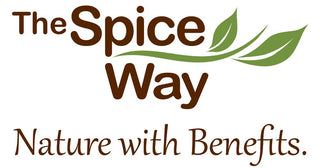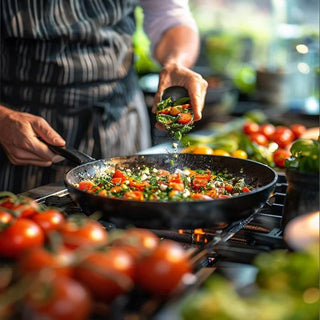Zaatar is a staple in Middle Eastern cuisine, revered for its unique blend of flavors and versatility. While many people associate zaatar with a specific spice mix, the term “zaatar” refers to both an herb and the blend that carries its name. In this blog, we will discuss what a real zaatar is.
A Native to the Middle East
The plant behind the zaatar is Origanum syriacum, a wild thyme variety native to the Middle East. Its leaves have a distinctive, earthy flavor with hints of oregano and marjoram. It grows in the wild across mountainous regions, especially in countries like Lebanon, Syria, and Jordan. In some areas, it is also referred to as Syrian oregano. While fresh zaatar is highly prized, the herb is often dried for cooking, offering an aromatic fragrance.
A Traditional Blend
The zaatar spice blend itself consists of dried zaatar leaves, sumac, and salt. The proportions and exact ingredients can vary slightly depending on regional and family traditions.
-
Za'atar Herb: As mentioned, the base of the mix is the zaatar herb itself, which gives the blend its characteristic flavor and aroma.
-
Sesame Seeds: Roasted sesame seeds add a rich, nutty depth to the mix, balancing the earthiness of the zaatar herb.
-
Sumac: Sumac is a red spice made from the dried berries of the Sumac plant. It imparts a tangy, citrus-like flavor that complements the earthy zaatar herb and the nuttiness of sesame.
-
Salt: Salt is typically added to enhance the flavor and combine all elements.
Some variations of zaatar may include additional ingredients such as fennel seeds, thyme, or cumin, but these are often considered regional differences rather than essential components.
How to Recognize Authentic Zaatar?
When searching for real zaatar, it's essential to understand that “zaatar” can be used loosely. While the zaatar herb and spice mix is common in many Middle Eastern dishes, the quality and authenticity of the blend can vary. Authentic zaatar should ideally have the following characteristics:
-
Freshness: The zaatar herb should be freshly dried, not overly processed. Freshness is key to maintaining the herb’s aromatic oils and flavors.
-
Proportions: A real zaatar mix should have a balanced proportion of ingredients. Too much sesame or salt can overpower the distinct flavor of the zaatar herb, making it less authentic.
-
Sumac: Look for a zaatar blend that incorporates real Sumac. Some commercial blends may substitute it with citric acid or other tangy ingredients, which can alter the flavor profile.
-
No artificial preservatives: Real zaatar should not contain synthetic additives or preservatives. The best zaatar is made from natural, simple ingredients, showcasing herbs and spices.
The Versatility of Real Zaatar
Zaatar is much more than just a seasoning; it is a symbol of Middle Eastern culinary culture. It’s used in many dishes, from bread to meats and dips. Here are some common ways real zaatar is used:
-
Man'ousheh: A popular Lebanese flatbread topped with zaatar and olive oil, often eaten for breakfast.
-
Za'atar Bread: In many regions, zaatar is spread on dough and then baked into a soft, aromatic flatbread.
-
Seasoning for Meats: Zaatar is often used to season lamb, chicken, and fish, providing a herby, aromatic coating.
-
Salads and Dips: Zaatar can be sprinkled on salads or mixed with yogurt to create a flavorful dip.
-
Garnish: As a Garnish, Zaatar adds a finishing touch to soups, roasted vegetables, or even hummus.
Why is Zaatar So Popular?
The popularity of zaatar can be attributed to its versatility and depth of flavor. It strikes a unique balance between savory, tangy, and nutty, making it a perfect complement to many dishes. Its rich history in the Middle East also plays a role, as zaatar has been used for centuries in culinary and medicinal applications. The blend is often seen as a symbol of home, passed down through generations.
Zaatar’s health benefits, attributed to its anti-inflammatory properties, are also why it continues gaining popularity in global markets. The sesame seeds provide a healthy dose of omega-3 fatty acids, while the zaatar herb is believed to have digestive benefits.
Zaatar’s Role in Middle Eastern Culture
Zaatar’s presence in Middle Eastern culture goes beyond its culinary uses. It is deeply rooted in tradition and considered a home and hospitality symbol. For many families in the Levant, zaatar is a staple in daily life. The aroma of freshly baked man'ousheh, sprinkled with zaatar and olive oil, is a scent that brings people together.
In some cultures, zaatar is even seen as a symbol of resilience. In Lebanon, for example, it has been referred to as the "herb of resistance" due to its longstanding presence in the region’s diet. Zaatar’s continued popularity throughout history reflects its importance as a culinary and cultural staple.
Zaatar in Modern Cuisine
While Zaatar has a long-standing history in the Middle East, it has gained popularity worldwide in recent years due to its versatility and health benefits. Today, chefs around the globe incorporate zaatar into fusion dishes, experimenting with its distinctive flavor profile. Some contemporary uses of zaatar include:
-
As a topping: For pizzas and flatbreads, Zaatar pairs perfectly with the rich, doughy texture of these dishes, adding a fresh, herby kick.
-
In wraps and sandwiches: Zaatar can be sprinkled over hummus or mixed with olive oil, spread onto pita bread, then rolled up with fresh vegetables or grilled meats.
-
In dressings and marinades: The tanginess of sumac and the herbal notes of zaatar make it an excellent addition to salad dressings and marinades, giving dishes a vibrant, Middle Eastern-inspired twist.
-
In desserts: Some modern chefs even use zaatar in sweet dishes, pairing it with honey and labneh (strained yogurt) or seasoning pastries, creating a unique fusion of flavors that is both surprising and delicious.
Conclusion
In short, we have discussed what is a real zaatar. Real zaatar is a timeless spice blend with deep cultural significance, rich flavor, and numerous health benefits. Whether used in traditional Middle Eastern dishes or contemporary, innovative recipes, its unique taste adds depth and complexity to any meal. By understanding the history and authenticity of real zaatar, we can better appreciate its role in Middle Eastern cuisine. The Spice Way has the best spices, you can buy them there.
FAQS
1. What is zaatar made of?
Zaatar is a spice blend traditionally made from dried zaatar herbs, sesame seeds, sumac, and salt. Some variations may include other ingredients like fennel or cumin, but these are considered regional variations.
2. How do you use zaatar in cooking?
Zaatar can be used in various ways. For instance, it can be included as a topping for flatbreads, mixed with olive oil for dipping bread, vegetables, and salads. It also works well in marinades and dressings.
3. What does zaatar taste like?
Zaatar has a unique, earthy flavor with herbal notes from the zaatar herb, a tangy kick from sumac, and a nutty crunch from sesame seeds. Combining these flavors gives zaatar a balanced, savory taste that pairs well with many dishes.
4. Is zaatar healthy?
Yes, zaatar is considered healthy. It contains antioxidant-rich herbs, sesame seeds with healthy fats, and sumac with anti-inflammatory properties. It can support digestion, boost immunity, and provide essential vitamins and minerals.
5. Can I make my zaatar at home?
Yes, making zaatar at home is easy and allows you to adjust the proportions to your taste. Combine dried zaatar leaves, sesame seeds, sumac, and salt for an essential blend. You can experiment by adding spices like fennel or cumin for a personalized touch.


